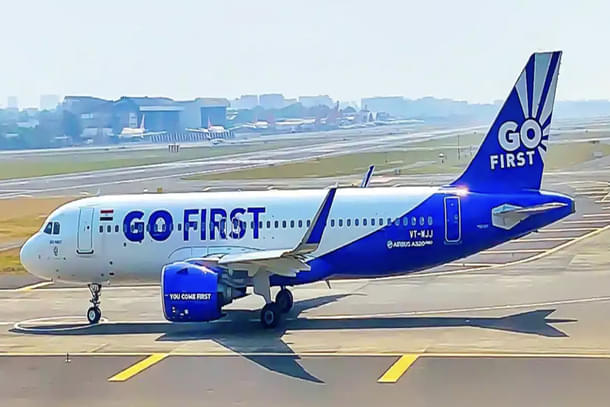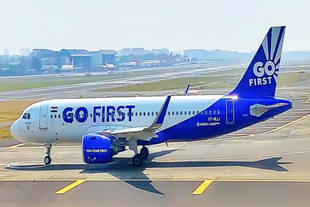Business
Go First Isn't The First To Go: All Who Went Down Forgot Three Realities Of Flying In Indian Skies
R Jagannathan
May 05, 2023, 11:50 AM | Updated 05:10 PM IST
Save & read from anywhere!
Bookmark stories for easy access on any device or the Swarajya app.


Go First isn’t the first to go down in flames.
The Nusli Wadia-owned airline has filed for bankruptcy to give itself some future chance of survival, but, as the case of Jet Airways shows, taking off from the insolvency court’s runway is tough.
Even before takeoff, staff, pilots and even the chief executive officer have quit.
The Indian landscape is littered with airlines that went bust ever since the skies above were opened up for private players in the 1990s: Damania, East West, NEPC, ModiLuft, Paramount, Kingfisher and Jet are only some of them, even if we leave out the ones that (temporarily) survived by merging with other airlines (Air Sahara, Air Deccan, Indian Airlines). And this is not even an exhaustive list (read this Wikipedia page for the full laundry list of failed airlines).
Go First has blamed problems with Pratt & Whitney engines as one of the reasons for its cash running out. One can also legitimately blame Covid-19 for the stresses that developed in airline balance-sheets after March 2020.
But precipitating events cannot be the reason for any airline’s long-term failure, given the sheer number of them dropping out of the skies into the insolvency court’s backyard.
The real issues relate to three other factors. If you have not figured those out, you don’t deserve to fly.
The first, and most important reason, is that it is an easy sector to get into in terms of the initial cash infusion.
Air Akasa, for example, got a fund infusion of around Rs 280 crore from Rakesh Jhunjhunwala for a 40 per cent plus stake shortly before his death last year. It has ordered 72 planes from Boeing.
The list price of those planes would be in excess of Rs 72,000 crore. So, with an equity base of barely Rs 400-500 crore, one can buy planes worth 140-150 times that value. That’s huge leverage.
The thing in the airline industry is that most costs can be shifted from fixed to variable. Planes can be leased (even owned planes can be sold and leased back), and most other expenses are variable costs (fuel, staff, airport charges, etc).
This implies that in a highly capital-intensive industry, one can get in with very little initial capital. This explains, at least partly, why there are scores of dead airlines the world over, and yet new entrants are eager to enter thinking they can do better.
The exit costs are borne by banks, lessors, and employees. It is one thing for the well-funded and privatised Air India, now owned by the Tatas, to buy 470 aircraft from Boeing and Airbus, quite another for an Air Akasa to do 72 planes with so little capital of its own. It has no fallback option if the going gets tough.
The second, and next more important lesson, relates to Indian realities. India is a low-fare airline market, but, surprise, surprise, there is nothing low cost about anything that airlines have to pay for: aviation fuel costs are one of the highest in the world (and that won’t change), airport costs are rising and set to go higher; pilots cost a bomb, and aircraft lease rentals can rise or fall depending on global demand. As someone said when Kingfisher went down in 2011, India has low-fare airlines, not low-cost airlines.
To make low-fare airlines viable, you need low-cost, no-frills airports for a start. On the other hand, consider the investment cost of the Navi Mumbai airport, which has bloated to over Rs 16,700 crore, due largely to high land acquisition costs.
These costs are thanks to the UPA-era Land Acquisition Act, which boosted the cost of rural-urban land many-fold. Navi Mumbai land acquisition costs rose 250 per cent between the time the airport was planned, and the time the land was actually acquired.
So, when the airport finally starts operating some time in 2024, the user development and airport fees that passengers and airlines will pay will be extortionately high.
Given high land acquisition costs, it is anybody’s guess what the 80 new airports planned between now and 2027-28, including many greenfield ones, will cost airlines and passengers. The key to making low-fare airlines viable is low fuel costs and low airport landing and parking fees. There is little sign of that happening as yet.
Third, given these in-built high cost factors, the only viable airlines are those which manage to operate at the lowest possible costs. This means lowering the average cost of fuel per passenger flown by flogging fuel-efficient aircraft for longer hours every day and with more “bums on seats” in each flight.
Maintenance costs must be pared to the bone by using as few aircraft types as possible. IndiGo, which was the only airline in the last decade to minimise all kinds of costs, is thus the only one viable at current cost structures.
But even it will face challenges as it buys different aircraft types (Airbus, Boeing, and short-haul aircraft) for catering to different kinds of routes. Jet and Kingfisher went down because they could not manage low fares without low operating costs.
Without addressing these three realities, no airline can really be successful in India. What separated IndiGo from the rest is just this key aspect of the business model.
Go First will go nowhere, even after it emerges from the insolvency courts, without rethinking its entire model. Ask Vijay Mallya, who thought he could run a low-margin airline with the costs of the high-margin liquor business. The net result, he has lost some of his most profitable liquor businesses to partners. Aviation is a business, a tough business, not a trophy in the portfolio.
Jagannathan is former Editorial Director, Swarajya. He tweets at @TheJaggi.





